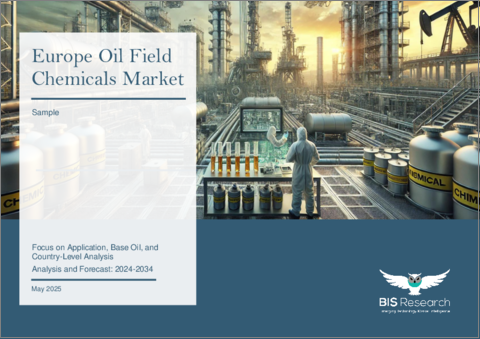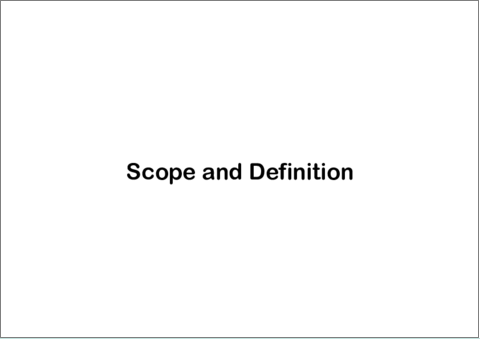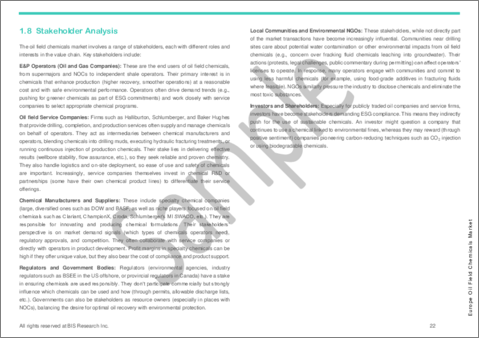|
|
市場調査レポート
商品コード
1726991
欧州の油田用化学品市場:用途別、ベースオイル別、国別 - 分析と予測(2024年~2034年)Europe Oil Field Chemicals Market: Focus on Application, Base Oil, and Country-Level Analysis - Analysis and Forecast, 2024-2034 |
||||||
カスタマイズ可能
|
|||||||
| 欧州の油田用化学品市場:用途別、ベースオイル別、国別 - 分析と予測(2024年~2034年) |
|
出版日: 2025年05月19日
発行: BIS Research
ページ情報: 英文 68 Pages
納期: 1~5営業日
|
全表示
- 概要
- 図表
- 目次
欧州の油田用化学品の市場規模は、2024年の34億2,000万米ドルから2034年には52億3,000万米ドルに達し、予測期間の2024年~2034年のCAGRは4.33%になると予測されています。
石油増進回収(EOR)、生産、掘削活動のための高性能で環境に優しい化学ソリューションへのニーズの高まりが、欧州での市場拡大を後押ししています。事業者は、エネルギー需要が増加し、探査が確立された北海油田や非在来型地域に向かうにつれて、坑井の生産量を増加させ、採掘を迅速化し、厳格なEU規則を遵守するために、最新の油田化学物質にますます依存するようになっています。
厳しいREACH規制や、欧州の野心的なネット・ゼロ目標やESG目標により、環境にやさしい製剤やグリーン製造技術の採用が増加しており、コンプライアンス要件を満たしながら環境への影響を最小限に抑えることができます。貯留層の性能と操業効率の改善は、カスタマイズされたポリマーシステム、生分解性界面活性剤、ナノテクノロジーによって強化された添加剤などのスマート化学物質の開発によって推進されています。
| 主要市場統計 | |
|---|---|
| 予測期間 | 2024年~2034年 |
| 2024年の評価 | 34億2,000万米ドル |
| 2034年の予測 | 52億3,000万米ドル |
| CAGR | 4.33% |
正確でデータに裏打ちされた介入は、リアルタイムの化学薬品投与システムとAI主導の監視プラットフォームの組み合わせによって可能となり、費用対効果と拡張性をさらに最大化します。一方、欧州の生産センターの開発や、世界な特殊化学品企業と現地サプライヤーとの戦略的提携は、サプライチェーンの堅牢性を強化し、規制遵守を保証し、現地の需要への対応力を向上させています。これらの開発が相まって、先進的な油田用化学品産業が発展し、欧州の事業者が環境に対する責任を維持しながら、深刻化するエネルギー問題に対処する準備が整いつつあります。
この地域における探鉱、掘削、生産、増進回収(EOR)事業はすべて、欧州の油田用化学品産業によって大いに助けられています。特に北海と東欧では石油・ガス産業が発展しているため、オペレーターは坑井の健全性を維持し、炭化水素の回収率を高め、厳しい環境規制の遵守を保証するために、最先端の化学ソリューションにますます依存するようになっています。市場に出回っている製品には、腐食防止剤、脱乳化剤、殺生物剤、界面活性剤、スケール防止剤、ポリマーをベースとしたEOR添加剤などがあります。
欧州のREACH基準、ネット・ゼロ目標、より一般的な持続可能性目標に準拠した、高性能で環境に優しい配合物へのニーズの高まりが、大きな成長の原動力となっています。効率を犠牲にすることなく環境への影響を軽減するため、化学メーカーは再生可能な原料、ナノテクノロジーによって強化された添加剤、生分解性界面活性剤などを試しています。さらに、リアルタイムの化学物質管理システムやAIベースのモニタリングなど、デジタル技術の統合により、油田アプリケーション全体の精度と作業効率が向上しています。
現地の製造能力は増強され、地域のサプライヤーと国際的な特殊化学品メーカーとの戦略的提携を通じてサプライチェーンの強靭性が強化されています。欧州の油田用化学品市場は、原油価格の変動、複雑な規制、生産コストの増大といった障害に直面しながらも、技術革新、コンプライアンス、より持続可能なエネルギー方法へのシフトにより、着実に拡大すると予想されます。
動向
- 生分解性、非毒性、REACH準拠の化学配合へのシフト
- AIを活用した化学物質のモニタリングや投与システムなどのスマート技術の統合
- 石油増進回収法(EOR)のためのナノテクノロジーと先進界面活性剤の使用の増加
- 現地生産を促進するための世界企業と地域サプライヤーとの戦略的パートナーシップ
- ESG目標に沿ったグリーン製造とクローズドループ化学システムに対する需要の高まり
促進要因
- 成熟油田や複雑な掘削環境における高性能化学薬品へのニーズの高まり
- 厳しい環境規制とネット・ゼロ目標が環境に優しい製品イノベーションを促進
- 特に北海における海洋探査・生産の拡大
- 持続可能なエネルギーと化学の研究開発に対する政府の奨励策とEUの資金援助
- 先進化学物質別操業効率と生産最適化への注目の高まり
課題
- 規格に適合した持続可能な化学製剤を開発するための高い研究開発コスト
- EU加盟国間の規制の複雑さが市場の標準化に影響
- 探鉱予算と化学品需要に影響を与える原油価格の変動
- 地域別は、特殊化学品製造のための原料の入手が困難
- 地政学的緊張と輸送コストの上昇別サプライチェーンへの圧力
当レポートでは、欧州の油田用化学品市場について調査し、市場の概要とともに、用途別、ベースオイル別、国別の動向、および市場に参入する企業のプロファイルなどを提供しています。
目次
エグゼクティブサマリー
第1章 市場:業界展望
- 深海およびフロンティア探査への移行
- 上流ポートフォリオにおける合併・買収活動の増加
- 貯留層最適化のためのデジタル技術の導入拡大
- 探査と生産における持続可能性とESGの重要性の高まり
- サプライチェーンの概要
- 規制状況
- 研究開発レビュー
- ステークホルダー分析
- 市場力学:概要
第2章 地域
- 地域のサマリー
- 欧州
- 地域概要
- 市場成長促進要因
- 市場成長抑制要因
- 主要企業
- 用途
- 製品
- 欧州(国別)
第3章 市場-競合ベンチマーキングと企業プロファイル
- 今後の見通し
- 地理的評価
- 企業プロファイル
- BASF
- Clariant
- Solvay
- Croda International Plc
- Kemira
第4章 調査手法
List of Figures
- Figure 1: Europe Oil Field Chemicals Market (by Scenario), $Million, 2023, 2027, and 2034
- Figure 2: Europe Oilfield Chemicals Market (by Application), $Million, 2023, 2027, and 2034
- Figure 3: Europe Oil Field Chemicals Market (by Product), $Million, 2023, 2027, and 2034
- Figure 4: Key Events
- Figure 5: Supply Chain and Risks within the Supply Chain
- Figure 6: Value Chain Analysis
- Figure 7: Pricing Analysis for Oil Field Chemicals Market (in metric ton/$)
- Figure 8: Patent Analysis (by Country), January 2021-February 2025
- Figure 9: Patent Analysis (by Company), January 2021-February 2025
- Figure 10: Impact Analysis of Market Navigating Factors, 2024-2034
- Figure 11: Norway Oil Field Chemicals Market, $Million, 2023-2034
- Figure 12: Germany Oil Field Chemicals Market, $Million, 2023-2034
- Figure 13: France Oil Field Chemicals Market, $Million, 2023-2034
- Figure 14: U.K. Oil Field Chemicals Market, $Million, 2023-2034
- Figure 15: Russia Oil Field Chemicals Market, $Million, 2023-2034
- Figure 16: Italy Oil Field Chemicals Market, $Million, 2023-2034
- Figure 17: Rest-of-Europe Oil Field Chemicals Market, $Million, 2023-2034
- Figure 18: Data Triangulation
- Figure 19: Top-DOWn and Bottom-Up Approach
- Figure 20: Assumptions and Limitations
List of Tables
- Table 1: Market Snapshot
- Table 2: Opportunities across Region
- Table 3: Competitive Landscape Snapshot
- Table 4: Trends in the Oil Field Chemicals Market
- Table 5: List of Regulations for the Oil Field Chemicals Market
- Table 6: Oil Field Chemicals Market (by Region), $Million, 2023-2034
- Table 7: Europe Oil Field Chemicals Market (by Application), $Million, 2023-2034
- Table 8: Europe Oil Field Chemicals Market (by Base Oil), $Million, 2023-2034
- Table 9: Norway Oil Field Chemicals Market (by Application), $Million, 2023-2034
- Table 10: Norway Oil Field Chemicals Market (by Base Oil), $Million, 2023-2034
- Table 11: Germany Oil Field Chemicals Market (by Application), $Million, 2023-2034
- Table 12: Germany Oil Field Chemicals Market (by Base Oil), $Million, 2023-2034
- Table 13: France Oil Field Chemicals Market (by Application), $Million, 2023-2034
- Table 14: France Oil Field Chemicals Market (by Base Oil), $Million, 2023-2034
- Table 15: U.K. Oil Field Chemicals Market (by Application), $Million, 2023-2034
- Table 16: U.K. Oil Field Chemicals Market (by Base Oil), $Million, 2023-2034
- Table 17: Russia Oil Field Chemicals Market (by Application), $Million, 2023-2034
- Table 18: Russia Oil Field Chemicals Market (by Base Oil), $Million, 2023-2034
- Table 19: Italy Oil Field Chemicals Market (by Application), $Million, 2023-2034
- Table 20: Italy Oil Field Chemicals Market (by Base Oil), $Million, 2023-2034
- Table 21: Rest-of-Europe Oil Field Chemicals Market (by Application), $Million, 2023-2034
- Table 22: Rest-of-Europe Oil Field Chemicals Market (by Base Oil), $Million, 2023-2034
- Table 23: Market Share, 2023
Introduction to Europe Oil Field Chemicals Market
The Europ oil field chemicals market is projected to reach $5.23 billion by 2034 from $3.42 billion in 2024, growing at a CAGR of 4.33% during the forecast period 2024-2034. The growing need for high-performance, environmentally friendly chemical solutions for enhanced oil recovery (EOR), production, and drilling activities is propelling the market expansion in Europe. Operators are depending more and more on modern oil-field chemistries to increase well output, expedite extraction, and adhere to strict EU rules as energy demands rise and exploration moves towards established North Sea fields and unconventional regions.
Adoption of eco-friendly formulations and green manufacturing techniques is rising due to strict REACH regulations and Europe's ambitious Net Zero and ESG targets, which minimise environmental impact while satisfying compliance requirements. Improvements in reservoir performance and operational efficiency are being driven by developments in smart chemistries, such as customised polymer systems, biodegradable surfactants, and additives boosted by nanotechnology.
| KEY MARKET STATISTICS | |
|---|---|
| Forecast Period | 2024 - 2034 |
| 2024 Evaluation | $3.42 Billion |
| 2034 Forecast | $5.23 Billion |
| CAGR | 4.33% |
Accurate, data-supported interventions are made possible by the combination of real-time chemical dosing systems and AI-driven monitoring platforms, which further maximises cost-effectiveness and scalability. In the meantime, the development of European production centres and strategic alliances between global speciality chemical firms and local suppliers are strengthening the robustness of the supply chain, guaranteeing regulatory compliance, and improving responsiveness to local demand. Together, these developments are advancing the advanced oil-field chemicals industry and preparing European operators to handle the escalating energy difficulties while maintaining environmental responsibility.
Market Introduction
Exploration, drilling, production, and enhanced oil recovery (EOR) operations in the region are all greatly aided by the European oil field chemicals industry. Because of the developed oil and gas industry, especially in the North Sea and Eastern Europe, operators are depending more and more on cutting-edge chemical solutions to preserve well integrity, increase hydrocarbon recovery, and guarantee adherence to stringent environmental regulations. Products on the market include corrosion inhibitors, demulsifiers, biocides, surfactants, scale inhibitors, and EOR additives based on polymers.
The growing need for high-performing, environmentally friendly formulations that comply with REACH standards in Europe, Net-Zero targets, and more general sustainability objectives is a major growth driver. To lessen their influence on the environment without sacrificing efficiency, chemical manufacturers are experimenting with renewable raw materials, additives boosted by nanotechnology, and biodegradable surfactants. Additionally, precision and operational efficiency are being improved across oilfield applications through the integration of digital technology, including as real-time chemical management systems and AI-based monitoring.
Local manufacturing capacity is being increased and supply chain resilience is being enhanced through strategic partnerships between regional suppliers and international speciality chemical producers. The market for oil field chemicals in Europe is expected to increase steadily due to innovation, compliance, and the shift to more sustainable energy methods, even in the face of obstacles such fluctuating oil prices, complicated regulations, and growing production costs.
Market Segmentation:
Segmentation 1: Oil Field Chemicals Market (by Application)
- Cementing and Stimulation
- Fracturing
- Cementing and Acidizing
- Oil production Chemical
- Drilling Fluids
Segmentation 2: Oil Field Chemicals Market (by Product)
- Inhibitors
- Demulsifiers
- Rheology Modifiers
- Friction Reducers
- Biocides
- Surfactants
- Foamers
- Polymers
- Others
Segmentation 3: Oil Field Chemicals Market (by Country)
- Germany
- France
- U.K.
- Italy
- Russia
- Norway
- Rest-of-Europe
Europe Oil Field Chemicals Market Trends, Drivers and Challenges
Trends
- Shift toward biodegradable, non-toxic, and REACH-compliant chemical formulations.
- Integration of smart technologies like AI-driven chemical monitoring and dosing systems.
- Increasing use of nanotechnology and advanced surfactants for enhanced oil recovery (EOR).
- Strategic partnerships between global players and regional suppliers to boost local production.
- Rising demand for green manufacturing and closed-loop chemical systems aligned with ESG goals.
Drivers
- Growing need for high-performance chemicals in mature fields and complex drilling environments.
- Strict environmental regulations and Net-Zero targets driving eco-friendly product innovation.
- Expansion of offshore exploration and production, particularly in the North Sea.
- Government incentives and EU funding for sustainable energy and chemical R&D.
- Increasing focus on operational efficiency and production optimization through advanced chemistries.
Challenges
- High R&D costs for developing compliant and sustainable chemical formulations.
- Regulatory complexity across EU member states affecting market standardization.
- Volatility in crude oil prices impacting exploration budgets and chemical demand.
- Limited availability of raw materials for specialty chemical production in some regions.
- Pressure on supply chains due to geopolitical tensions and rising transportation costs.
Table of Contents
Executive Summary
Scope and Definition
1 Market: Industry Outlook
- 1.1 Shift Toward Deepwater and Frontier Exploration
- 1.2 Rising Merger and Acquisition Activity in Upstream Portfolios
- 1.3 Increased Deployment of Digital Technologies for Reservoir Optimization
- 1.4 Growing Emphasis on Sustainability and ESG In Exploration and Production
- 1.5 Supply Chain Overview
- 1.5.1 Value Chain Analysis
- 1.5.2 Pricing Analysis
- 1.6 Regulatory Landscape
- 1.7 Research and Development Review
- 1.7.1 Patent Filing Trend (by Country and Company)
- 1.8 Stakeholder Analysis
- 1.8.1 Use Case
- 1.9 Market Dynamics: Overview
- 1.9.1 Market Drivers
- 1.9.1.1 Rising Upstream Exploration and Production Activities and Demand for Enhanced Oil Recovery Techniques
- 1.9.1.2 Technological Advancements in Chemical Formulations
- 1.9.1.3 Regulatory Incentives for Environment-Friendly Chemicals
- 1.9.2 Market Restraints
- 1.9.2.1 Price Volatility of Raw Materials and Supply Chain Disruptions
- 1.9.2.2 Strict Regulatory and Environmental Compliance Requirements
- 1.9.3 Market Opportunities
- 1.9.3.1 Growth in Sustainable, Eco-Friendly Chemical Solutions
- 1.9.3.2 Expansion in Unconventional Oil and Gas Developments
- 1.9.3.3 Strategic partnerships for R&D and market expansion
- 1.9.1 Market Drivers
2 Regions
- 2.1 Regional Summary
- 2.2 Europe
- 2.2.1 Regional Overview
- 2.2.2 Driving Factors for Market Growth
- 2.2.3 Factors Challenging the Market
- 2.2.4 Key Companies
- 2.2.5 Application
- 2.2.6 Product
- 2.2.7 Europe (by Country)
- 2.2.7.1 Norway
- 2.2.7.1.1 Application
- 2.2.7.1.2 Product
- 2.2.7.2 Germany
- 2.2.7.2.1 Application
- 2.2.7.2.2 Product
- 2.2.7.3 France
- 2.2.7.3.1 Application
- 2.2.7.3.2 Product
- 2.2.7.4 U.K.
- 2.2.7.4.1 Application
- 2.2.7.4.2 Product
- 2.2.7.5 Russia
- 2.2.7.5.1 Application
- 2.2.7.5.2 Product
- 2.2.7.6 Italy
- 2.2.7.6.1 Application
- 2.2.7.6.2 Product
- 2.2.7.7 Rest-of-Europe
- 2.2.7.7.1 Application
- 2.2.7.7.2 Product
- 2.2.7.1 Norway
3 Markets - Competitive Benchmarking & Company Profiles
- 3.1 Next Frontiers
- 3.2 Geographic Assessment
- 3.3 Company Profiles
- 3.3.1 BASF
- 3.3.1.1 Overview
- 3.3.1.2 Top Products/Product Portfolio
- 3.3.1.3 Top Competitors
- 3.3.1.4 End-Use Applications
- 3.3.1.5 Key Personnel
- 3.3.1.6 Analyst View
- 3.3.1.7 Market Share, 2023
- 3.3.2 Clariant
- 3.3.2.1 Overview
- 3.3.2.2 Top Products/Product Portfolio
- 3.3.2.3 Top Competitors
- 3.3.2.4 End-use Applications
- 3.3.2.5 Key Personnel
- 3.3.2.6 Analyst View
- 3.3.2.7 Market Share, 2023
- 3.3.3 Solvay
- 3.3.3.1 Overview
- 3.3.3.2 Top Products/Product Portfolio
- 3.3.3.3 Top Competitors
- 3.3.3.4 End-use Applications
- 3.3.3.5 Key Personnel
- 3.3.3.6 Analyst View
- 3.3.3.7 Market Share, 2023
- 3.3.4 Croda International Plc
- 3.3.4.1 Overview
- 3.3.4.2 Top Products/Product Portfolio
- 3.3.4.3 Top Competitors
- 3.3.4.4 End-use Applications
- 3.3.4.5 Key Personnel
- 3.3.4.6 Analyst View
- 3.3.4.7 Market Share, 2023
- 3.3.5 Kemira
- 3.3.5.1 Overview
- 3.3.5.2 Top Products/Product Portfolio
- 3.3.5.3 Top Competitors
- 3.3.5.4 End-use Applications
- 3.3.5.5 Key Personnel
- 3.3.5.6 Analyst View
- 3.3.5.7 Market Share, 2023
- 3.3.1 BASF
4 Research Methodology
- 4.1 Data Sources
- 4.1.1 Primary Data Sources
- 4.1.2 Secondary Data Sources
- 4.1.3 Data Triangulation
- 4.2 Market Estimation and Forecast






